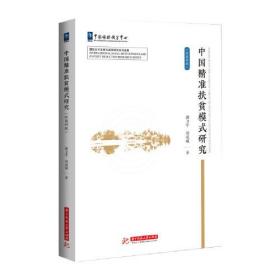
中国精准扶贫模式研究(汉英对照)
全新正版 极速发货
¥ 40.61 4.1折 ¥ 98 全新
库存3件
广东广州
认证卖家担保交易快速发货售后保障
作者谭卫平,刘成斌
出版社华中科技大学出版社
ISBN9787568075824
出版时间2021-10
装帧平装
开本16开
定价98元
货号1202510377
上书时间2024-09-30
- 最新上架
商品详情
- 品相描述:全新
- 商品描述
-
作者简介
谭卫平,经济学博士,中国靠前扶贫中心副主任。在原国务院扶贫办系统工作达26年,先后担任原国务院扶贫办靠前合作司副司长、行政人事司副司长。2002年至2005年作为第四批援疆干部担任新疆维吾尔自治区扶贫办副主任。谭卫平博士是国家公务员局和国务院学位办授予的“全国公共管理专业研究生教育校外导师”,曾担任国务院学位办高校博士点评审评委。他承担了大量中国对发展中国家中、不错官员培训的授课任务,直接听课的发展中国家官员超过三千人次。曾公开出版《中国企业在东南亚投资的减贫效果分析》《靠前减贫理论与前沿问题2020》《世界各国减贫概要(第二辑)》等多部论著,组织编辑《靠前减贫动态》、《中国扶贫开发年鉴》等多部刊物。谭卫平博士有丰富的对外减贫援助项目经验,主持东亚三国减贫示范合作技术援助项目的设计、实施与管理;还是世界银行-中国扶贫贷款项目的负责人。
目录
目录上篇 中文部分章 绪论3一、研究背景及意义3二、文献综述4三、概念界定及理论基础13四、研究方法16五、操作路线17第二章 二阶观察与中国扶贫政策变迁18一、整体模式扶贫:以体制改革促进扶贫阶段(1978—1986年)18二、开发模式扶贫:区域开发式扶贫阶段(1986—1992年)19三、经济模式扶贫:市场经济针对性反哺的项目制扶贫阶段(1993—2000年)20四、行动模式扶贫:以村庄为基础的参与式扶贫阶段(2001—2012年)21五、社会扶贫模式:精准扶贫阶段(2013—2020年)23六、精准扶贫策略的特征分析25第三章 等值功能主义与精准扶贫政策体系30一、互动系统31二、组织力量系统35三、整体帮扶系统38四、社会监督与考核系统40第四章 系统理性与精准扶贫实践方略45一、精准识别子系统:追求公平正义45二、精准帮扶子系统:注重协调发展48三、精准管理子系统:重视制度创新51四、精准考核子系统:坚持系统思维53五、小结56第五章 全面耦合:中国精准扶贫模式分析57一、理论来源:结构与系统57二、理论界定:系统与耦合58三、理论结构:四重耦合59四、理论意义:社会整合与融合66第六章 系统理论与典型国家扶贫比较68一、印度的扶贫经验69二、巴西的扶贫经验73三、墨西哥的扶贫经验78四、典型国家扶贫经验比较82第七章 总结与展望84一、精准扶贫政策的社会成效84二、精准扶贫策略的社会创新性89三、精准扶贫与后扶贫时代的脱贫巩固问题93四、发展中国家扶贫工作建议与世界减贫的未来96参考文献99下篇 英文部分Chapter One:Introduction109ⅠResearch Background and Significance109ⅡLiterature Review111ⅢDefinitions and Theoretical Basis125ⅣResearch Method130ⅤTechnology Route131Chapter Two:Second-order Observation and the Changes of China’s Poverty Alleviation Policies133ⅠOverall Mode of Poverty Alleviation: Promoting Poverty Alleviation through System Reform (1978-1986)134ⅡDevelopment Mode Poverty Alleviation: Regional Development Stage of Poverty Alleviation (1986-1992) 135ⅢPoverty Alleviation in the Economic Mode: Project-based Poverty Alleviation Stage of Targeted Feedback from Market Economy(1993-2000)137ⅣAction Mode for Poverty Alleviation: Villagebased Participatory Poverty Alleviation stage(2001-2012) 139ⅤSo Mode for Poverty Alleviation: Targeted Poverty Alleviation Stage (2013-2020)141ⅥAnalysis of the Characteristics of Targeted Poverty Alleviation Strategies146Chapter Three:Equivalent Functionalism and the System of Targeted Poverty Alleviation Policy155ⅠInteractive System156ⅡSystem for Organizing Forces164ⅢIntegrated Poverty Alleviation System170ⅣSo Supervision and Assessment System174Chapter Four: Systematic Rationality and Strategy of Targeted Poverty Alleviation Practice182ⅠAccurate Identification Subsystem: Pursuing Fairness and Justice182ⅡThe Subsystem of Targeted Poverty Alleviation: Focusing on Coordinated Development188ⅢThe Subsystem of Accurate Management: Attaching Importance to System Innovation192ⅣThe Subsystem of Accurate Assessment: Adhering to Systematic Thinking197ⅤSummary201Chapter Five: Comprehensive Coupling: Analysis of China’s Targeted Poverty Alleviation Mode203ⅠTheoretical Source: Structure and System203ⅡTheoretical Definitions: System and Coupling205ⅢTheoretical Structure: Quadruple Coupling206ⅣTheoretical Significance: So Integration and Unity219Chapter Six: The Comparison between System Theory and Poverty Alleviation in Typical Countries221ⅠIndia’s Experience in Poverty Alleviation222ⅡBrazil’s Experience in Poverty Alleviation228ⅢMexico’s Experience in Poverty Alleviation235ⅣComparison of the Experience of Poverty Alleviation in Typical Countries241Chapter Seven: Summary and Prospect244ⅠThe So Effectiveness of Targeted Poverty Alleviation Policies244ⅡThe So Innovation of Targeted Poverty Alleviation Strategies253ⅢTargeted Poverty Alleviation and the Consolidation of Poverty Alleviation in the Post-poverty Era259ⅣPoverty Alleviation Proposals for Developing Countries and the Future of Poverty Reduction in the World263Reference268
内容摘要
本书以卢曼的社会系统论为理论基础,从精准扶贫的理论渊源和实践经验入手,首先梳理新中国成立以来实施的扶贫政策,分析政策内容和特点,总结不同阶段的扶贫模式;其次从组织力量系统、互动系统、社会监督和考核系统、整体帮扶系统四个方面分析了精准扶贫的政策体系,包括责任体系、措施体系、投入体系、帮扶体系、社会动员体系、监督体系、考核评估体系等;再次从系统理性出发,分别论证精准识别、精准帮扶、精准管理、精准考核四个方面的生成逻辑、实践模式以及典型经验,然后在此基础上,从理论来源、理论界定、理论结构、理论意义四个方面对中国精准扶贫模式进行分析,同时对印度、巴西和墨西哥的精准扶贫实践进行比较剖析,得出其中的经验,*后在形成系统性的理论的基础上,科学分析后扶贫时代精准扶贫的新方向和世界减贫工作的未来发展。
主编推荐
本书重点关注贫困这一热点问题和中国精准扶贫这一重大社会实践方略,以社会复杂系统、社会耦合、等值功能主义、系统理性等理论为框架,创新性的从社会学的视角对中国精准扶贫模式进行二阶观察,论证模式高效运行的何以可能,为模式的精准性、时效性、创新性提供深度的理论释解。
相关推荐
— 没有更多了 —





















以下为对购买帮助不大的评价